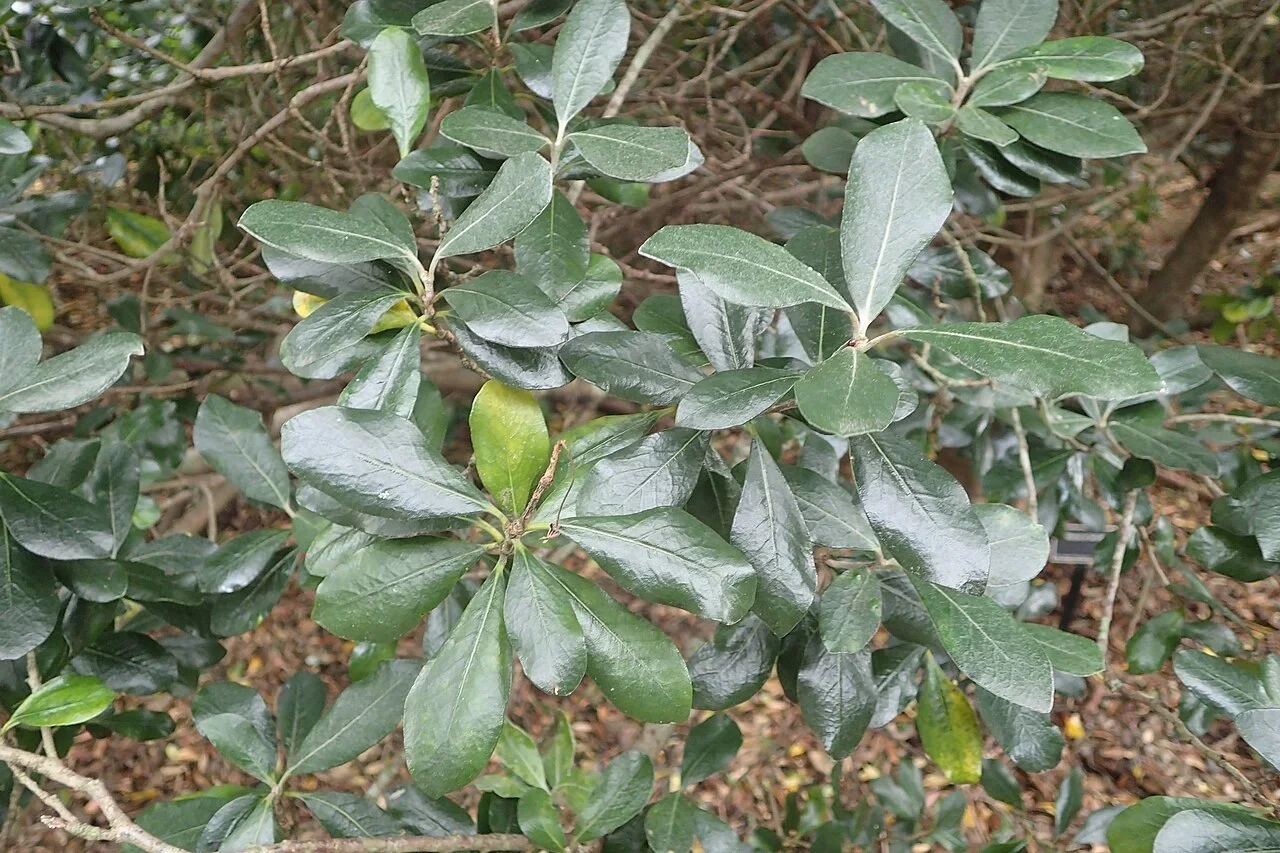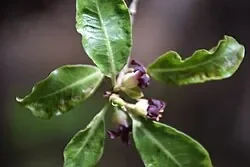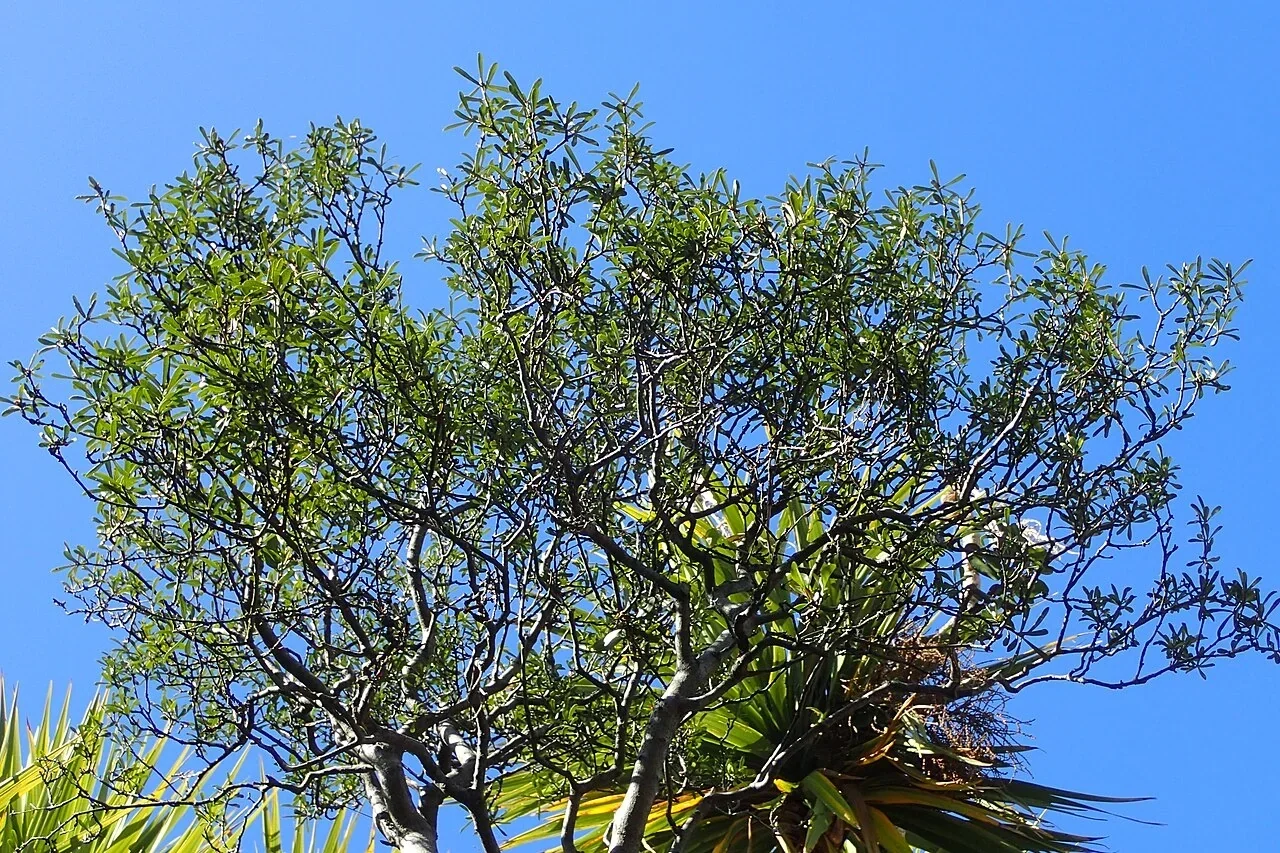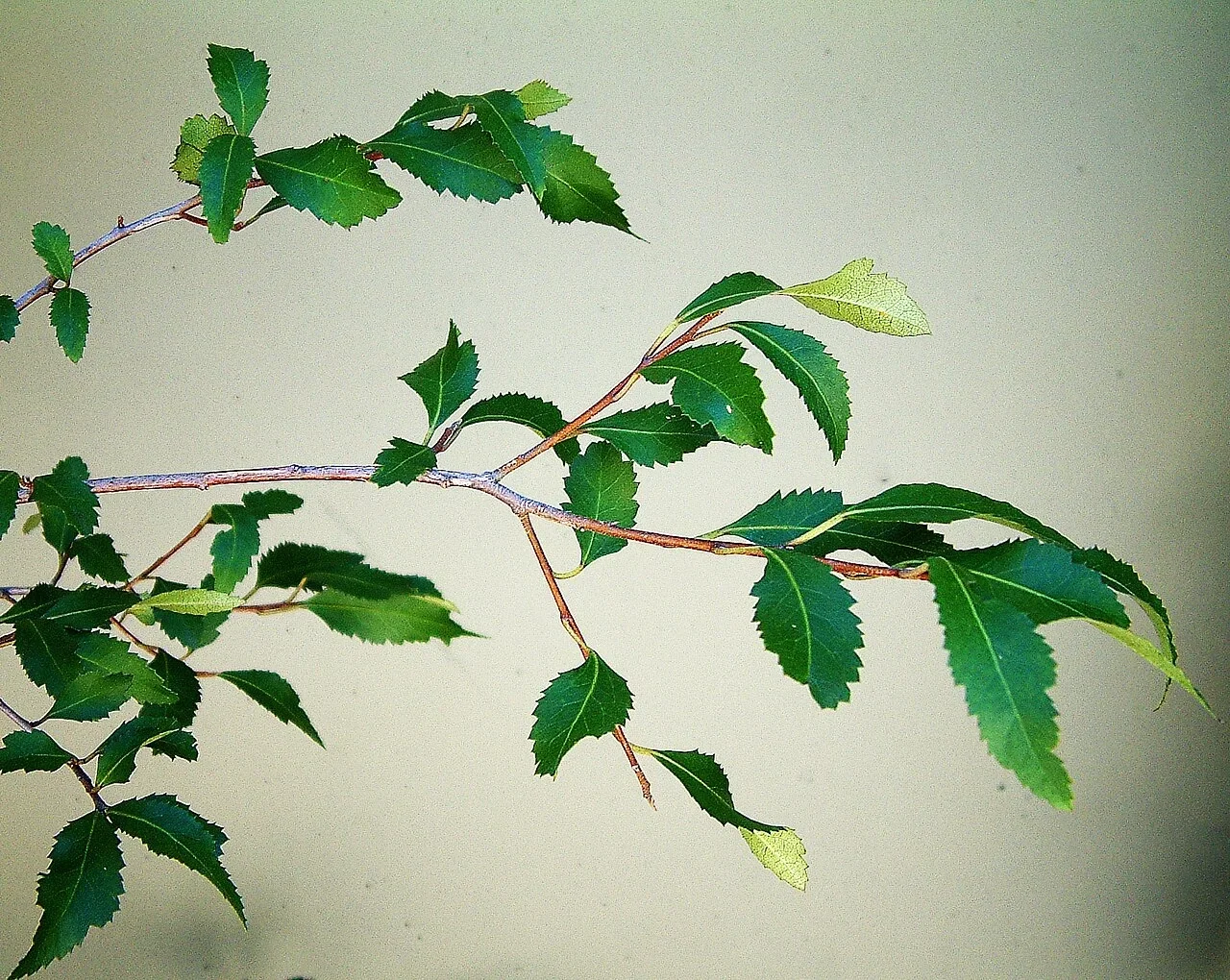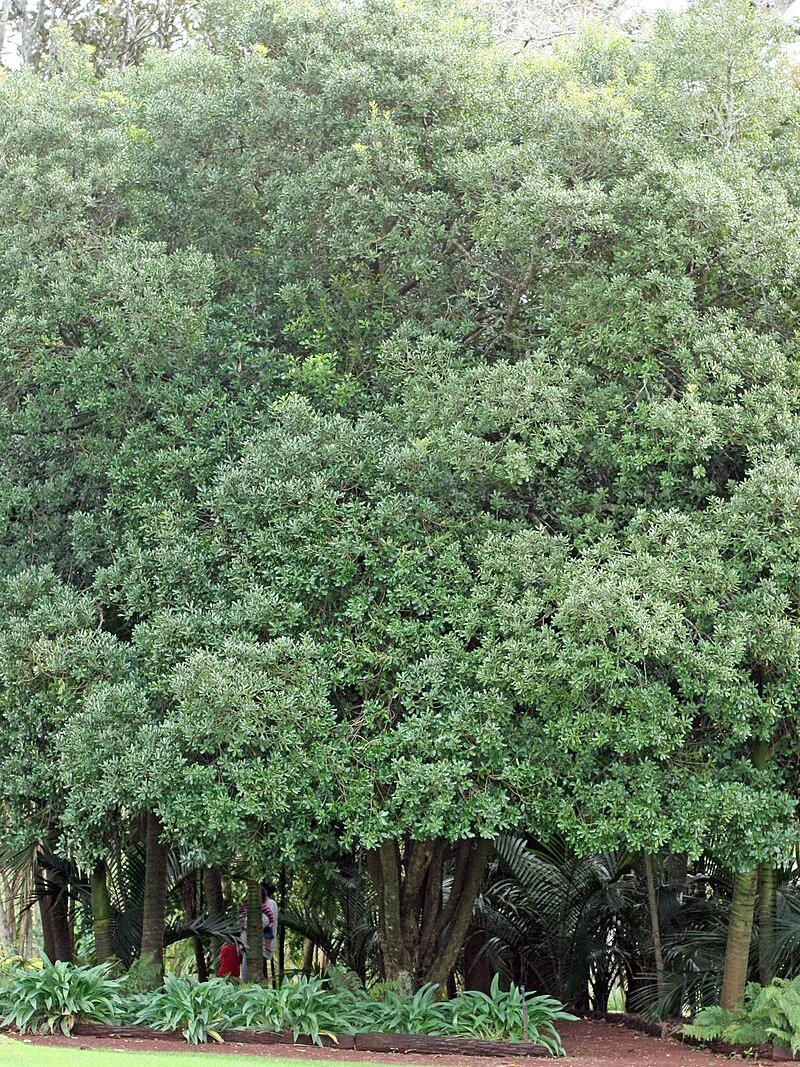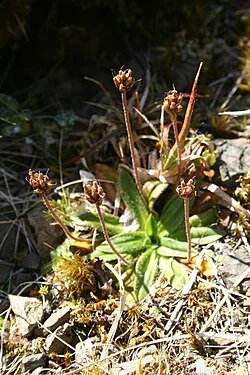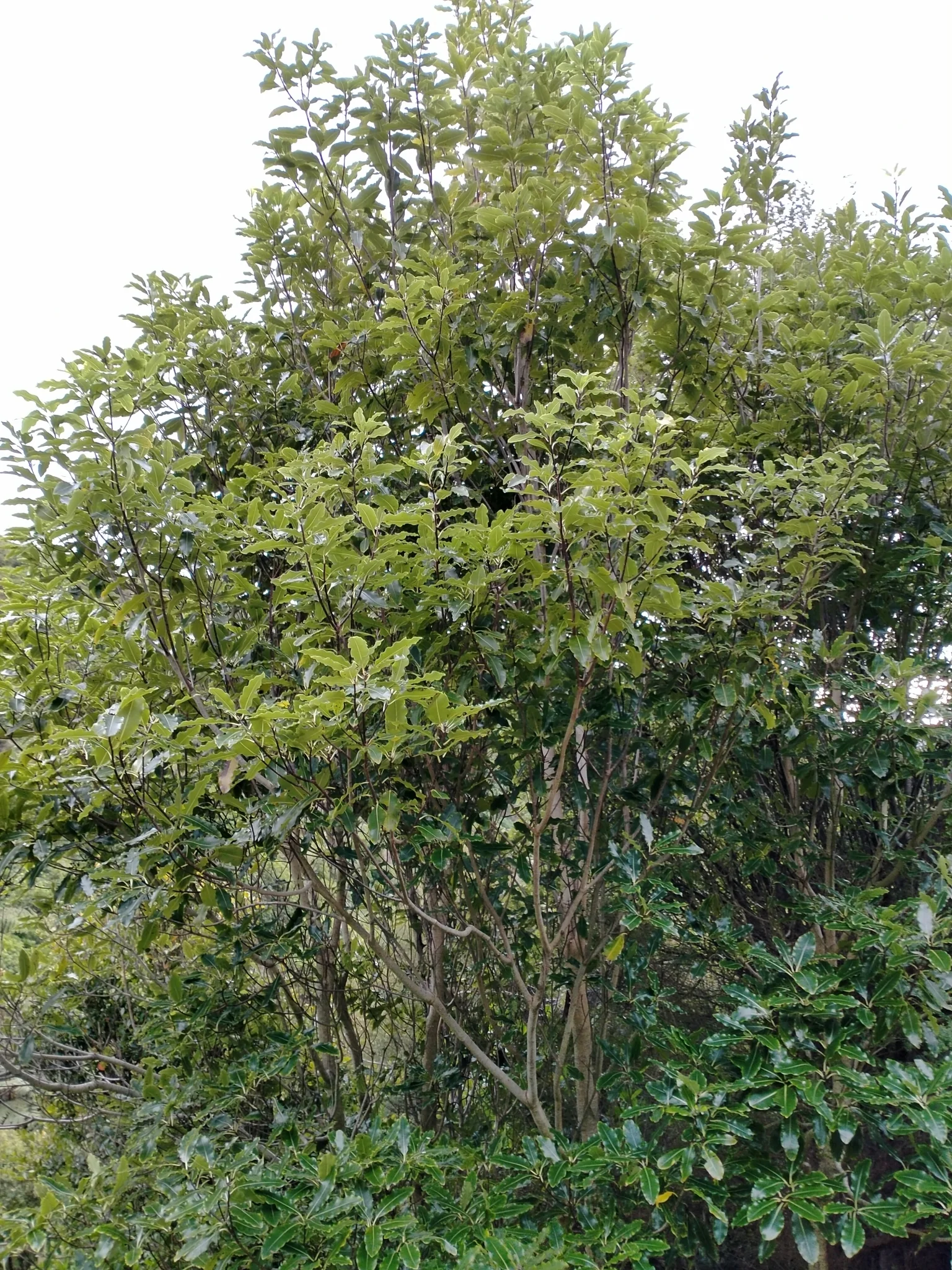
Tarata
Pittosporum eugenioides
Tarata (scientific name: Pittosporum eugenioides) Tarata, also known as Lemonwood, is a fragrant native tree with distinctive yellow-green leaves and highly scented cream flowers. Its lemony foliage fragrance and attractive form make it a popular choice for hedging, screening, and garden features throughout New Zealand. Explore more in the native plants index.

Plant Description
Botanical Features
Tarata (Pittosporum eugenioides), also known as lemonwood, is an evergreen tree endemic to New Zealand. It typically grows to 10-12 meters tall and up to 5 meters broad, starting conical when young and becoming more rounded with maturity. Its leaves are a distinctive yellow-green, often mottled with paler green or yellow-green, somewhat leathery, and glossy. They have curly or wavy edges and a prominent pale midrib. When crushed, the leaves emit a strong lemony smell, which is why it's also called lemonwood. The tree produces highly fragrant clusters of attractive yellow-cream flowers in spring (October to December in New Zealand). These flowers are followed by distinctive black, woody seed capsules that split open to reveal black, sticky seeds immersed in a dark yellow viscid pulp. The fruit takes between 12 and 14 months to ripen, so both ripe and unripe fruit can be present on the tree simultaneously.
Quick Facts
Overview
| Scientific Name | Pittosporum eugenioides |
|---|---|
| Height | 8-12 m |
| Spread | 4-5 m |
| Water Needs | Moderate |
| Light | Full sun to partial shade |
| Frost Tolerance | Good |
| Salt Tolerance | Moderate |
| Growth Rate | Moderate to fast |
| Lifespan | Long-lived |
Climate Best Suited to
Regional climate suitability across major New Zealand cities.
Regional Suitability
| City | Climate Suitability |
|---|---|
| Whangārei | Ideal |
| Auckland | Ideal |
| Hamilton | Ideal |
| Tauranga | Ideal |
| Rotorua | Ideal |
| Gisborne | Ideal |
| New Plymouth | Ideal |
| Napier | Ideal |
| Whanganui | Ideal |
| Palmerston North | Ideal |
| Wellington | Ideal |
| Nelson | Ideal |
| Christchurch | Ideal |
| Dunedin | Ideal |
| Invercargill | Ideal |
Natural Habitat
Tarata (Pittosporum eugenioides), also known as Lemonwood, is an evergreen tree native and endemic to New Zealand, found throughout both the North and South Islands. It is a highly adaptable species, thriving in a variety of habitats from coastal areas to montane situations, at altitudes ranging from sea level up to 600 meters (or sometimes cited as 2,500 feet, approximately 760 meters).
Preferred Conditions:
- Forest Margins and Clearings: Its natural habitat includes forest margins, forest clearings, and stream banks, where it often acts as a pioneer species in regenerating areas.
- Moist, Well-Drained Soils: Tarata prefers moist, fertile, and well-drained soils, but it is remarkably adaptable and can tolerate a range of soil types.
- Light Conditions: It grows well in both full sun and partial shade, making it versatile for various positions within its natural environment.
Distribution:
- Widespread: Its widespread distribution across both major islands of New Zealand highlights its ecological flexibility and ability to adapt to diverse climatic conditions.
- Coastal to Montane: It is a common component of regenerating and mature forests, from coastal areas where it tolerates some exposure to montane regions.
The presence of Pittosporum eugenioides in these diverse habitats underscores its ecological flexibility and its role in contributing to the biodiversity of New Zealand's native forests.
Plant Conservation
Pittosporum eugenioides, also known as tarata or lemonwood, is an evergreen tree endemic to New Zealand. It is common in both the North and South Islands, found in regenerating and mature forests, coastal areas, and montane situations.
According to the NZPCN, the conservation status of Pittosporum eugenioides was reassessed in 2022-2023 using the New Zealand Threat Classification System (NZTCS). While the specific current conservation status isn't explicitly stated as "threatened" or "endangered" across sources, it is described as a "common tree" and "endemic" to New Zealand. Other sources indicate it is "Conservation Significant: No" in Queensland, Australia, where it is an exotic species. The IUCN Red List status is not explicitly listed in summary sources.
Given its widespread distribution and commonality, it is generally considered "Not Threatened" in New Zealand.
Growing Requirements
Soil Requirements
Tarata is remarkably adaptable and tolerates most soil conditions, even growing well in poor soils. It prefers well-drained soils but is quite forgiving and hardy in various conditions from coastal to montane situations.
- Tolerates most soil conditions including poor soils
- Prefers well-drained soils but adaptable
- Hardy in coastal to montane situations
- Benefits from organic matter but not essential
- Good performer on forest margins and stream banks
Light Requirements
Tarata performs best in full sun but tolerates partial shade well. It naturally occurs in forest regeneration areas and margins where light conditions can be variable throughout the day.
- Best performance in full sun conditions
- Tolerates partial shade well
- Adaptable to forest margin light conditions
- Good for both open and semi-sheltered positions
Water Requirements
Tarata has moderate water needs and benefits from regular watering during summer, especially when establishing. Once established, it shows good drought resistance typical of pittosporums.
- Moderate water requirements
- Benefits from regular summer watering when establishing
- Somewhat drought resistant once established
- Good performance near streams and water features
- Avoid waterlogged conditions
Planting Guide
Tarata is a resilient and attractive evergreen native to New Zealand, valued for its ornamental appeal, ability to attract native birds, and its hardiness in various conditions. Proper planting and care will ensure this unique tree thrives in your garden.
1. Ideal Growing Conditions:
- Sunlight: Kaikōmako thrives in full sun to partial shade and is also shade-tolerant, making it versatile for different garden aspects.
- Soil: It prefers moist, fertile, and well-drained soils, but can tolerate a range of soil types, including heavy clay and loamy soils. It benefits from humus-rich, forest-type soils. Avoid waterlogged conditions.
- Climate and Tolerance: This tree is hardy and can handle wind, light coastal exposure, and frost once established.
2. Planting:
- Timing: Spring is the ideal time for planting container-grown Kaikōmako, allowing it to establish before the summer heat. Autumn planting is also suitable in milder climates.
- Preparation: Prepare the planting site by clearing weeds and enriching the soil with compost or other organic matter to improve fertility and drainage.
- Hole Size: Dig a hole that is twice the width of the root ball and to the same depth.
- Root Care: Gently tease out any pot-bound roots before placing the plant in the hole.
- Placement: Ensure the top of the root ball is level with the surrounding ground.
- Backfilling and Watering: Backfill the hole with soil, gently firming it around the roots to remove air pockets. Water thoroughly immediately after planting to settle the soil.
- Spacing: For native plantings or shelterbelts, space trees 2.5 to 3 meters apart. In garden settings, allow at least 3 meters between plants or structures to accommodate their mature size.
3. Ongoing Care:
- Watering: Water regularly during the first year to help establish a strong root system. Once established, it is tolerant of dry periods and requires minimal care, though consistent moisture is beneficial during hot, dry weather.
- Mulching: Apply organic mulch around the base of the plant to retain moisture and suppress weeds, keeping the mulch clear of the trunk.
- Fertilizing: A light fertilizer dressing in spring can support growth in soils with poor fertility. During the growing season, fertilize with balanced formulas, applying high nitrogen fertilizers in early spring and reducing feeding in autumn. Always water after fertilizing.
- Pruning: Kaikōmako requires minimal pruning once established. Light formative pruning may be beneficial in the early years to encourage good structure. Essential pruning includes removing dead branches and shaping, ideally conducted in early to late winter to minimize sap loss. Use clean, sharp tools.
Ecological Role
Flowers, Fragrance, and Fauna
Lemonwood/k� hūhū (Pittosporum eugenioides) bears abundant, scented spring flowers that draw pollinating insects; birds subsequently take the sticky seeds from split capsules. Its fast growth and persistent foliage make effective shelter and perches in regenerating forest and farmland edges.
Uses and Significance
Tarata provides important habitat for native birds and insects, with its highly fragrant flowers attracting nectar-loving species. The tree is common in regenerating forests and plays a key role in natural forest succession from coastal to montane areas.
Cultural and Traditional Significance
Tarata holds significant cultural importance for Māori, who traditionally used the aromatic gum and crushed leaves and flowers for perfume and hair oils. The strong lemony scent when leaves are crushed made it valuable for traditional scent-making, usually mixed with plant oils.
- Traditional Māori use for perfume and hair oils
- Aromatic gum used in traditional scent-making
- Crushed leaves and flowers used for fragrance
- Mixed with plant oils for traditional cosmetic applications
- Cultural significance in traditional Māori knowledge systems
Landscape and Garden Uses
Tarata is highly valued in cultivation for its fragrant foliage, attractive flowers, and versatility. It makes an excellent screening plant, shelter tree, or specimen, and is commonly available in both natural and variegated forms from garden centers.
- Outstanding for hedging and screening applications
- Excellent shelter tree reaching up to 10 meters
- Popular specimen tree for fragrant gardens
- Available in attractive variegated cultivars
- Responds well to pruning for formal hedges
- Low-maintenance once established
- Suitable for mixed native plantings
Landscaping Ideas
Hedges and Shelter
K� hūhū's fast, upright growth and dense, glossy foliage make a superb screen or clipped hedge. Use as a shelter belt for native borders and along driveways; trim lightly after flowering to maintain form.
Feature and Street Tree
The scented spring bloom and neat canopy suit urban plantings. Pair with Griselinia and small-leaved hebes for low-maintenance native structure.
Seasonal Care Calendar
Spring
Spring is the ideal planting season for Tarata and also when flowering begins. The first feeds with tree and shrub fertilizer should be applied as new growth starts, and any pruning for shape can be undertaken.
- Optimal planting season for new trees
- Begin flowering period (October-December)
- Apply first seasonal feed with tree and shrub fertilizer
- Good time for formative pruning and shaping
- Begin regular watering schedule for new plantings
Summer
Summer brings peak flowering with highly fragrant cream flowers in terminal sprays. This is when regular watering is most important, especially for establishing trees. Apply the second seasonal fertilizer feed.
- Peak flowering period with fragrant cream blooms
- Regular watering intervals essential
- Apply second feed with tree and shrub fertilizer
- Take semi-hardwood cuttings for propagation
- Enjoy the intense floral fragrance
Autumn
Autumn sees the development of distinctive black seed capsules and the end of the growing season. This is an excellent time for seed collection and a second planting opportunity as temperatures moderate.
- Seed capsules ripen to black (October-January)
- Good time for collecting fresh seeds
- Second optimal planting season
- Reduce watering frequency as growth slows
- Light pruning if needed before winter
Winter
Winter is the rest period for Tarata, requiring minimal care. The tree is frost-tolerant and needs little attention during dormancy, making it an excellent low-maintenance choice.
- Minimal care required during dormant period
- Good frost tolerance, no special protection needed
- No feeding or regular watering required
- Good time for structural pruning if necessary
- Plan garden improvements for spring
Pruning and Maintenance
Techniques and Timing
Tarata responds exceptionally well to pruning, making it ideal for formal hedging and topiary. Regular pruning maintains shape and promotes dense growth, while the tree's hardy nature means it can handle quite severe cutting back if needed.
- Responds excellently to pruning and shaping
- Ideal for formal hedging with regular trimming
- Can handle severe pruning for renovation
- Prune after flowering to maintain flower production
- Regular pruning promotes dense, compact growth
- Remove dead, damaged, or crossing branches as needed
- Sterilize tools to prevent disease spread
How to Grow Tarata
Tarata, also known as Lemonwood, is a fragrant native tree with distinctive yellow-green leaves and highly scented cream flowers. Its lemony foliage fragrance and attractive form make it a popular choice for hedging, screening, and garden features throughout New Zealand. This resilient and ecologically important tree adds a touch of natural elegance and year-round interest to any landscape, showcasing the rich biodiversity of New Zealand's forests. Understanding its propagation methods is key to successfully growing this delightful species.
From Seed (Recommended)
Propagating Tarata from fresh seed is a very easy and effective method, with quick germination typically occurring within a month. Seeds should be collected when the black capsules ripen and sown immediately for best results. Collect seeds when capsules turn black (October-January). Extract seeds from ripe capsules immediately. Sow fresh seeds in a well-draining seed-raising mix without delay. Keep soil consistently moist but not waterlogged. Provide bright, indirect light for germination. Expect germination within 3-4 weeks. Transplant seedlings when large enough to handle.
From Semi-Hardwood Cuttings
Semi-hardwood cuttings provide a reliable alternative method, particularly useful for maintaining specific characteristics of cultivars like variegated forms. Take cuttings from current season's growth in summer. Select semi-hardwood material 10-15cm long. Remove lower leaves, keeping top foliage. Dip in rooting hormone for improved success. Plant in a well-draining propagation mix. Maintain humidity with cover or misting. Roots develop within 6-10 weeks. Transplant when a well-rooted system is established.
Pests and Diseases
Tarata (Pittosporum eugenioides) can attract scale insects on lush growth. Prune in late winter to open the canopy and encourage air movement; avoid heavy summer nitrogen which exacerbates soft, pest-prone flushes.
Cultural Significance
Tarata (Pittosporum eugenioides), also known as Lemonwood, holds significant cultural value, particularly in Māori culture in New Zealand.
Its Cultural Significance Stems from Various Traditional Uses:
- Scent and Perfume: Māori traditionally used the crushed leaves and flowers, along with the gum from the tree, for scent. These were often mixed with plant oils like tītoki and k� hia, and bird fat, to create hair oils and perfumes.
- Oral Hygiene and Glue: The gum from the tarata tree was highly valued. When rolled into a ball and chewed, sometimes mixed with the sap of Pūhā, it was believed to cure bad breath and could last for generations. This gum also served as a type of glue, used to smear over ropes and knots to harden them, and to glue together small musical trumpets made from the wood.
- Symbol of Heritage: Beyond its practical applications, Pittosporum eugenioides symbolizes heritage and a deep connection to the land, especially in regions where it is endemic, such as Canterbury.
In modern contexts, while still appreciated for its cultural ties, it is also valued for its aesthetic appeal in landscaping and its role in conservation and restoration efforts due to its resilience and ability to establish a quick canopy.
Bonus Tip
Tarata's leaves have a strong lemony smell when crushed. The Māori traditionally used its fragrant leaves and flowers, mixed with fat, to create an unguent for anointing their bodies.
